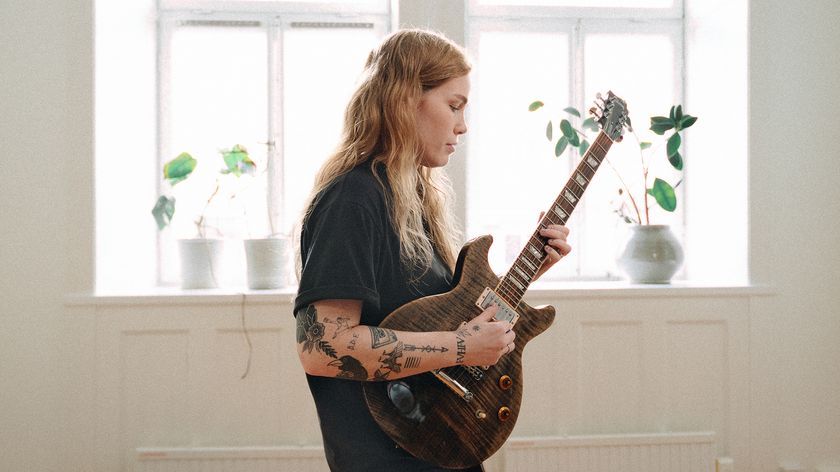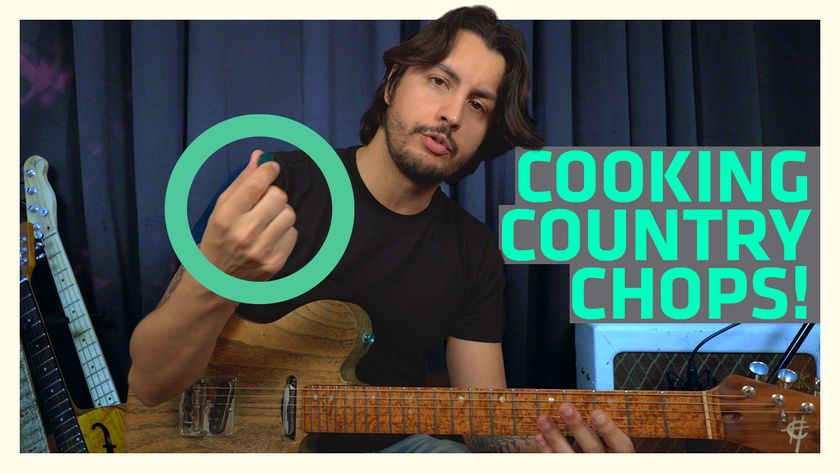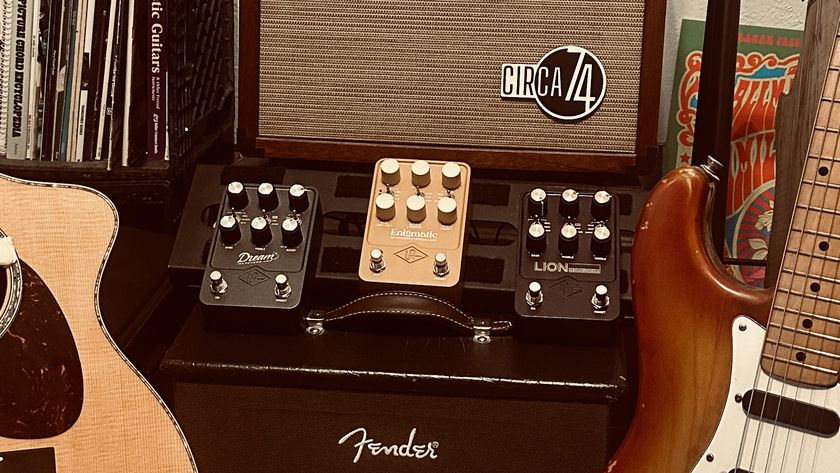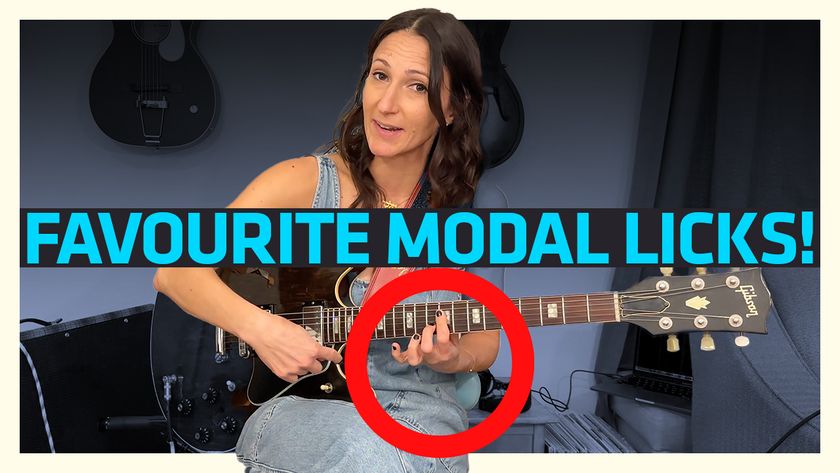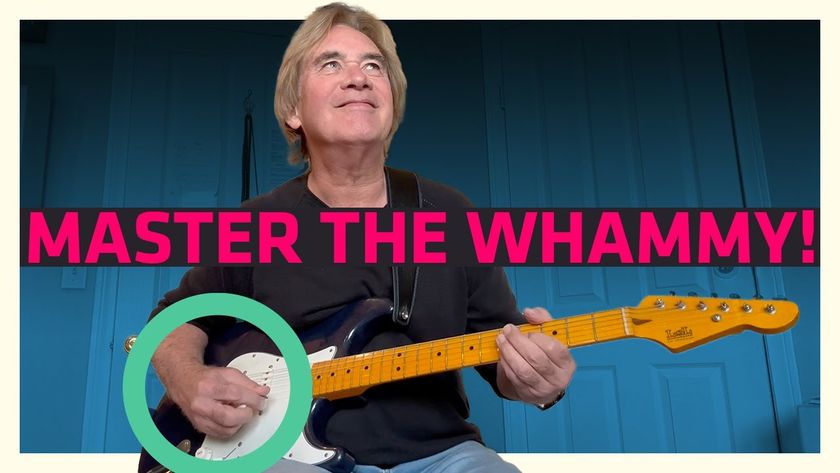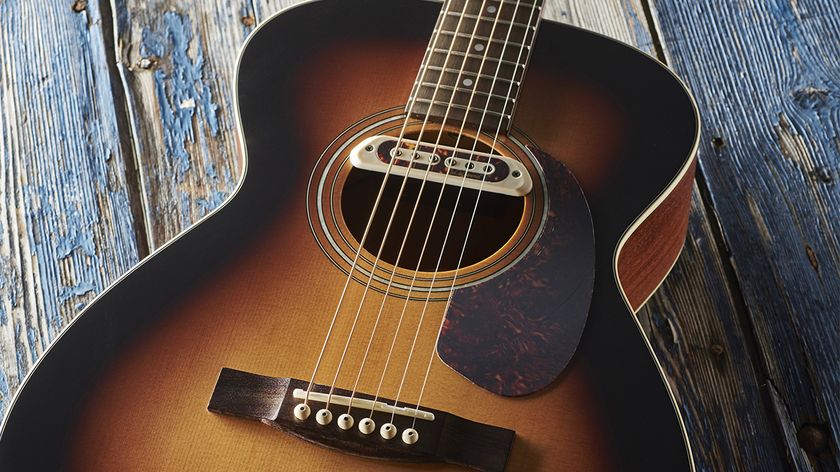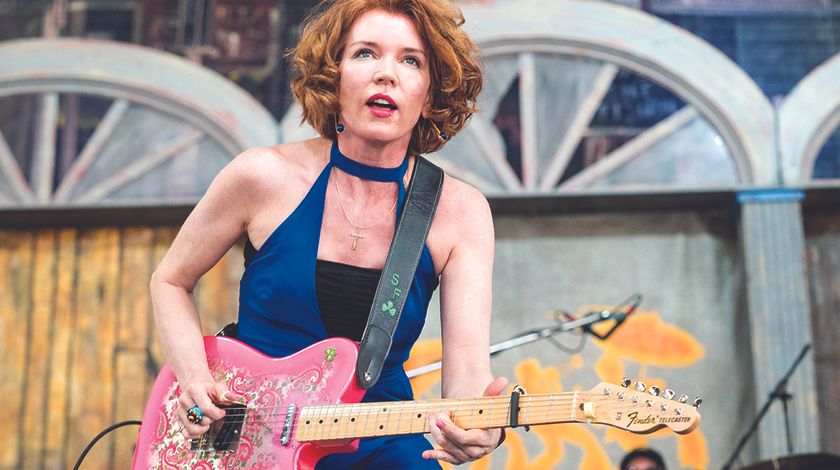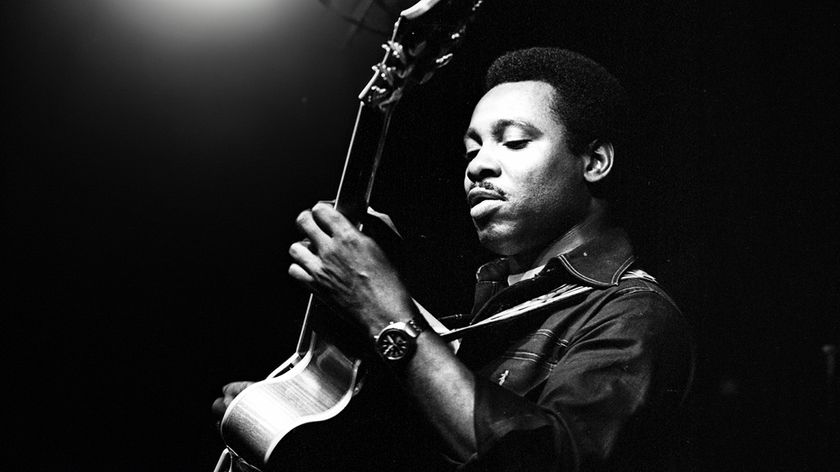Blues Turnarounds (Part 2)
How to play soulful, harmonically effective melodies over the last four bars of a blues progression in the styles of the genre’s greatest players.

In the first part of our lesson in navigating the last four bars of a blues guitar progression – the so-called “blues turnaround” – we looked at the styles of T-Bone Walker, B.B. King, Albert King, Peter Green and Eric Clapton. In this second part we conclude our study with a look at how guitar greats Carlos Santana, Gary Moore, Stevie Ray Vaughan, Robben Ford and Larry Carlton create soulful and harmonically effective melodies in their turnarounds, adding melodic and harmonic interest and resolution that leads the song back to the start of a new verse.
As we saw previously, a turnaround is usually improvised and generally occurs in the last two bars of a blues or jazz standard. In the context of a 12-bar blues progression, the vocal melody typically concludes at the beginning of the 10th bar, so instead of simply sitting on the tonic, or “one,” chord for two more bars, a chordal turnaround is inserted in bars 11 and 12 to provide interest and forward momentum for the progression to loop back to its start.
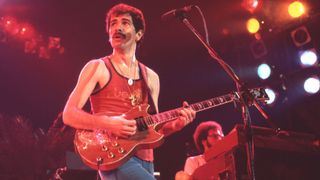
Turnaround licks are frequently played over four chords (two per bar), usually I-IV-I-V or the jazzier I-VI-ii-V (lowercase Roman numerals indicate minor-type chords), but there are many variations, as these lessons demonstrate. The chord types may be diatonic or non-diatonic (based on the parent scale of the key, or not) and are also influenced by the style of blues (major versus minor).
As per the previous lesson, each player will be represented here with three examples that cover major and minor keys and feature a range of grooves and tempos. In addition, because some licks can be interchanged between major and minor keys, our examples will start on the same root note. Once again, the examples are presented as they would occur in the last four bars of a 12-bar blues progression – bars 9 through 12. Remember that turnarounds also function as intros and can be used to launch a blues song or guitar solo.
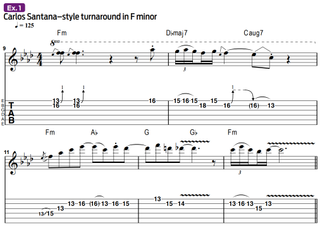
Carlos Santana’s famously Latin-influenced style and thick, singing tone provide a unique flavor to his blues playing. Performed in the key of F minor, the Santana-style turnaround changes in Ex. 1 (bars 11 and 12) are a variation on a jazzy i-VI-II-V progression, with tritone substitutions applied to what would be the VI and V chords (D and C), which become bIII (Ab) and bII (Gb), respectively. The lead melody in these bars begins on an Fm7 arpeggio (F Ab C Eb), which then follows the chromatically descending chord sequence by targeting the 5th of each chord.
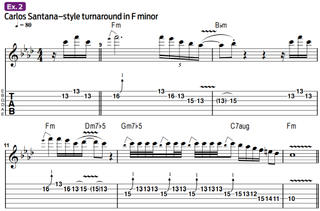
Throughout his career, Santana has excelled at the moody minor blues style, as shown in Ex. 2’s i-vi-ii-V turnaround, also played in the key of F minor. Interestingly, while the progression is based overall on the F natural minor scale (F G Ab Bb C Db Eb), with its minor, or “flatted,” sixth and seventh scale degrees (Db and Eb), the vi chord in the turnaround, Dm7b5, is rooted on the major sixth scale degree, which is “borrowed” from the parallel F melodic minor scale (F G Ab Bb C D E).
Notice how this is highlighted in bar 11, perfectly outlining the underlying Dm7b5 chord. Likewise, the V chord in bar 12, C7aug, is native to the parallel F harmonic minor scale (F G Ab Bb C Db E). This kind of use of modal mixture – borrowing notes and chords from different, parallel modes based on the same root – adds color to a progression by offering different “flavors” of major or minor to the harmony.
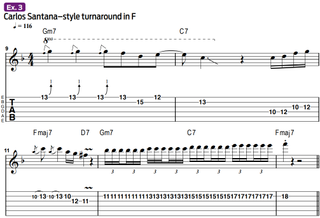
Ex. 3 offers a Santana-inspired I-VI-ii-V turnaround phrase in the key of F major, in which the VI chord (D7) is non-diatonic, meaning not native to the parent F major scale, but is rather the temporary V chord of the ii chord, Gm, or, more simply, the “V of ii.” Notice how the third of D7, F#, is deliberately played on beat three of bar 11. Targeting a chord tone on the change in this way, especially the third, fifth or seventh. is a highly effective technique to employ to achieve a harmonically strong melody.
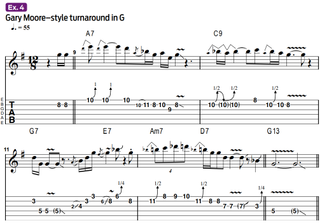
Gary Moore’s blues soloing style was soulfully passionate and hard hitting, often characterized by wide, ferocious finger vibrato and a bold, high-gain tone, but he also had a softer, jazzier side, which informs Ex. 4. Played in the key of G, the progression here includes a I-VI-ii-V turnaround (G7-E7- Am7-D7). Notice the way notes from the parallel scales G major pentatonic (G A B D E) and G minor pentatonic (G Bb C D F) are liberally combined and how in bars 11 and 12 the use of notes from G minor pentatonic add altered tensions to the E7 and D7 chords.
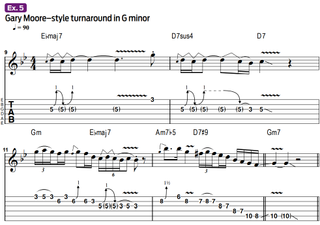
Moore also explored fusion with his band Colosseum II in the mid ’70s, and Ex. 5’s I-bVI-ii-V turnaround in the key go G minor (Gm-Ebmaj7-Am7b5-D7#9) is idiomatic to that style. The melody notes here are based mostly on G minor pentatonic, but notice in bar 11 the addition of the second, or ninth, A, and how the G harmonic minor scale (G A Bb C D Eb F#) is employed in bar 12 to generate D Phrygian-dominant sounds over the D7#9 chord.
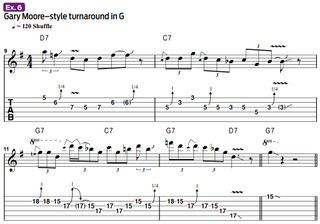
Ex. 6 is a Moore-style solo passage played over a medium blues shuffle in the key of G, with a standard I-IV-I-V turnaround in bars 11 and 12 (G7-C7- G7-D7). Despite the use of nothing more than the G minor pentatonic scale, with the exception of the first note, A, which alludes to D minor pentatonic (D F G A C) over the V chord, D7, every chord change is beautifully acknowledged and outlined, due to the placement of the notes.
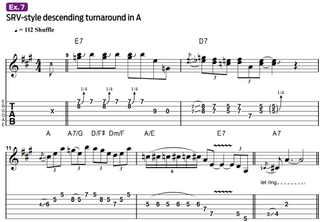
Stevie Ray Vaughan pioneered a blues rebirth in the ’80s, achieving a bold, muscular and distinctive electric guitar voice while remaining faithful to the heritage and language of the blues.
Performed in the key of A, Ex. 7 presents an SRV-style lead phrase played over a I-Ib7-IV-IVm-I-V turnaround with a descending bass line (achieved through the use of chord inversions) that illustrates how parallel major and minor pentatonic sounds can be mixed, T-Bone Walker-style, to create licks that are both cool- and warm-sounding. Notice the inclusion in bar 11 of the high B note, which is the ninth of A. This note lends a sophisticated, “uptown” quality to the melody.
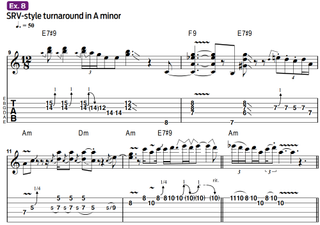
Played in the key of A minor, the i-iv-i-V turnaround in Ex. 8 (Am-Dm-Am-E7#9) is another example of “forward thinking.” Here, the first chord of the turnaround, Am, is anticipated with an A minor pentatonic lick at the end of bar 10. Notice also the trademark SRV hybrid-picked double-stops with grace-note hammer-ons in bar 11, which create a soulful, organ-like sound. In bar 12, A minor pentatonic licks provide altered tensions to the V chord, E7#9, with C serving as the #5, or b13, relative to E.
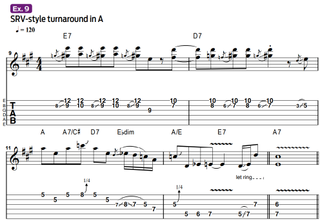
Presented in the key of A, Ex. 9 is a perfect example of how to simplify your turnaround approach, à la Stevie. Here, think only of the I and IV chords, A7 and D7. By ensuring your ideas and phrasing are strong, you can play over the entire sequence with an A blues-scale (A C D Eb E G) lick that concludes on the V chord (E7) on beat three of bar 12. Remember, it always sounds good to anticipate the resolution a beat or a half a beat early, as demonstrated here.
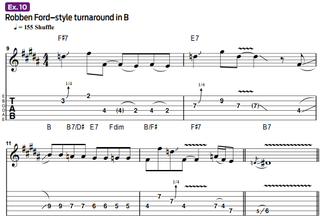
Robben Ford spent many years working as a sideman for acts that included the Yellow Jackets and Miles Davis before he set the world alight with his 1988 solo album, Talk to Your Daughter. The record showcased his virtuoso bluesy-fusion style, which he delivered with a fat, organic tone that many other players try to emulate. Ex. 10 shows a simple, yet effective Ford-style approach to a turnaround in the key of B that applies a descending phrase in bar 11, which creates a cool-sounding contrary motion against the ascending bass line.
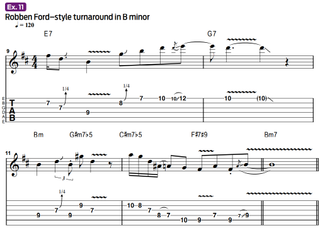
Ex. 11 is a Ford-style phrase played over a i-vi-ii-V turnaround in the key of B minor. Remember that the vi chord in a minor turnaround (G#m7b5, in this case) is almost always rooted on the major sixth interval, relative to the tonic key (see Ex. 2). This is highlighted in bar 11 here, where a G# note is played on beat three. In bar 12, the ii chord (C#m7b5) is intentionally and effectively ignored to allow more time and space for a lick based on the tense-sounding F# Super-locrian mode (F# G A Bb C D E) to play out across the entire bar. This provides a strong, welcome resolution to the Bm tonic chord in bar 13 (bar 1 of the next 12-bar chorus).
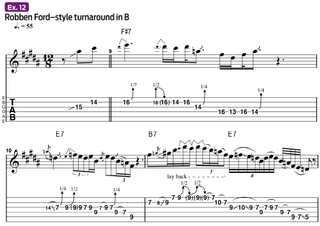
Ford will frequently add the major-sixth interval to the minor pentatonic, allowing him to create a 13th sound over the tonic chord, as demonstrated in bar 11 of the I-IV-I-V turnaround shown in the key of B in Ex. 12. As the progression moves to the IV chord (E7), the tonic minor blues scale (B D E F F# A) is used to craft a long, rolling-and-tumbling phase that fits the chord perfectly. In bar 12 the B major tonality is acknowledged with a double-stop hammer-on, from the minor third of B, D, to the major third, D#. Note how the lick concludes on the b7 of the V chord, F#7, on beat three, with a chromatic “walk-down from F# to F to E.
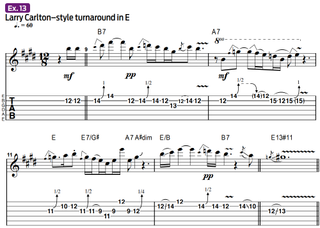
Larry Carlton’s early influences included jazz guitarists Joe Pass and Wes Montgomery and blues virtuoso B.B. King. His blues playing is marked by beautifully sophisticated and tasteful phrasing that’s never overly complex, and always features his trademark wide dynamic range. Played in the key of E, Ex. 13 is a jazzy-bluesy turnaround in Carlton’s style. Note the use of the B.B. King “blues box” in tonic position throughout bar 11 and later transposed to fit the V chord (B7) in the following bar (starting with the bend to the 14th fret).
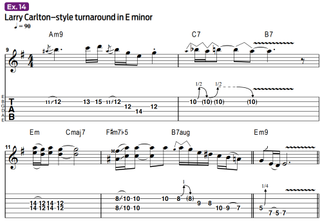
Ex. 14, in the key of E minor, offers a Carlton-style phrase played over a i-bVI-ii-V minor turnaround (Em-Cmaj7- F#m7b5-B7aug). The bVI chord in a minor turnaround shares the essential chord tones of the tonic minor and can effectively be ignored, hence the cool double-stop fourths in bar 12 that seem to float across the changes. These are followed in bar 13 by a major-sixth double-stop that outlines the ii chord’s b3 and b5 (A and C, respectively).

Ex. 15 wraps up our lesson with a Carlton-style phrase shown in the key of D and played over a I-VI-i-V turnaround (D7-B7-Em7-A7). In this final lick there’s a reminder of the effectiveness of mixing parallel major and minor pentatonic scales in your turnaround licks, in this case D major pentatonic (D E F# A B) and D minor pentatonic (D F G A C).
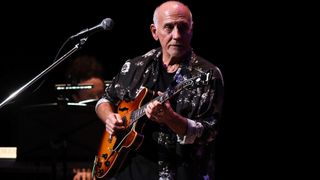
In bar 11 the D major tonality is enhanced by chromatically approaching the major third, F#, from a half step below, via a decorative finger slide. The rest of the lick draws from D minor pentatonic, highlighting chord tones and color notes from the accompanying harmony. Carlton does this effortlessly, and to achieve his level of easy sophistication will take dedicated practice and listening.
Get The Pick Newsletter
All the latest guitar news, interviews, lessons, reviews, deals and more, direct to your inbox!

"It’s like you’re making a statement. And you never know where it’ll lead." Pete Thorn shares the tip that convinced Joe Satriani he was the right guitarist for the SatchVai Band
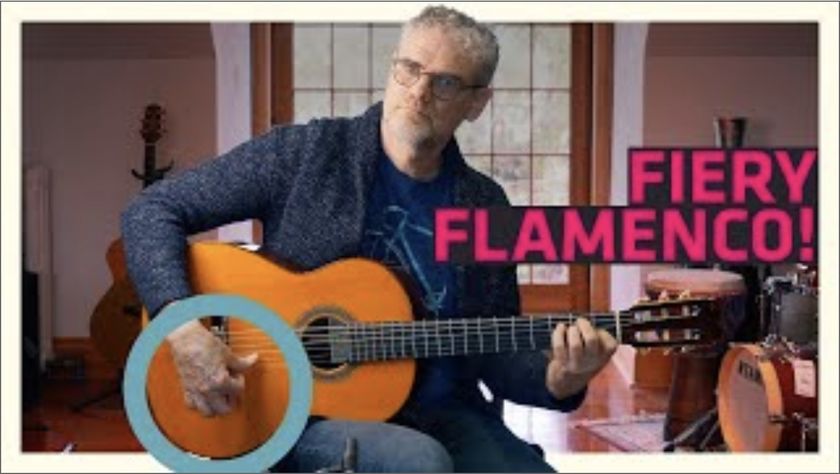
"This is something you could actually improvise with!" Add vibrant rhythms and sophisticated chords to your guitar playing with Jesse Cook’s five essential flamenco techniques
